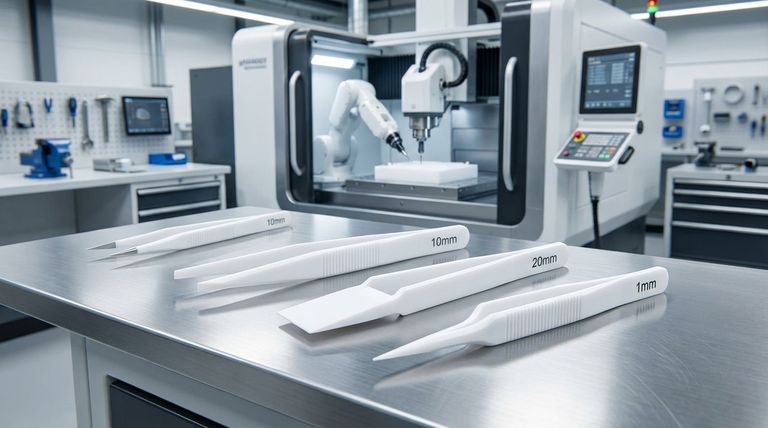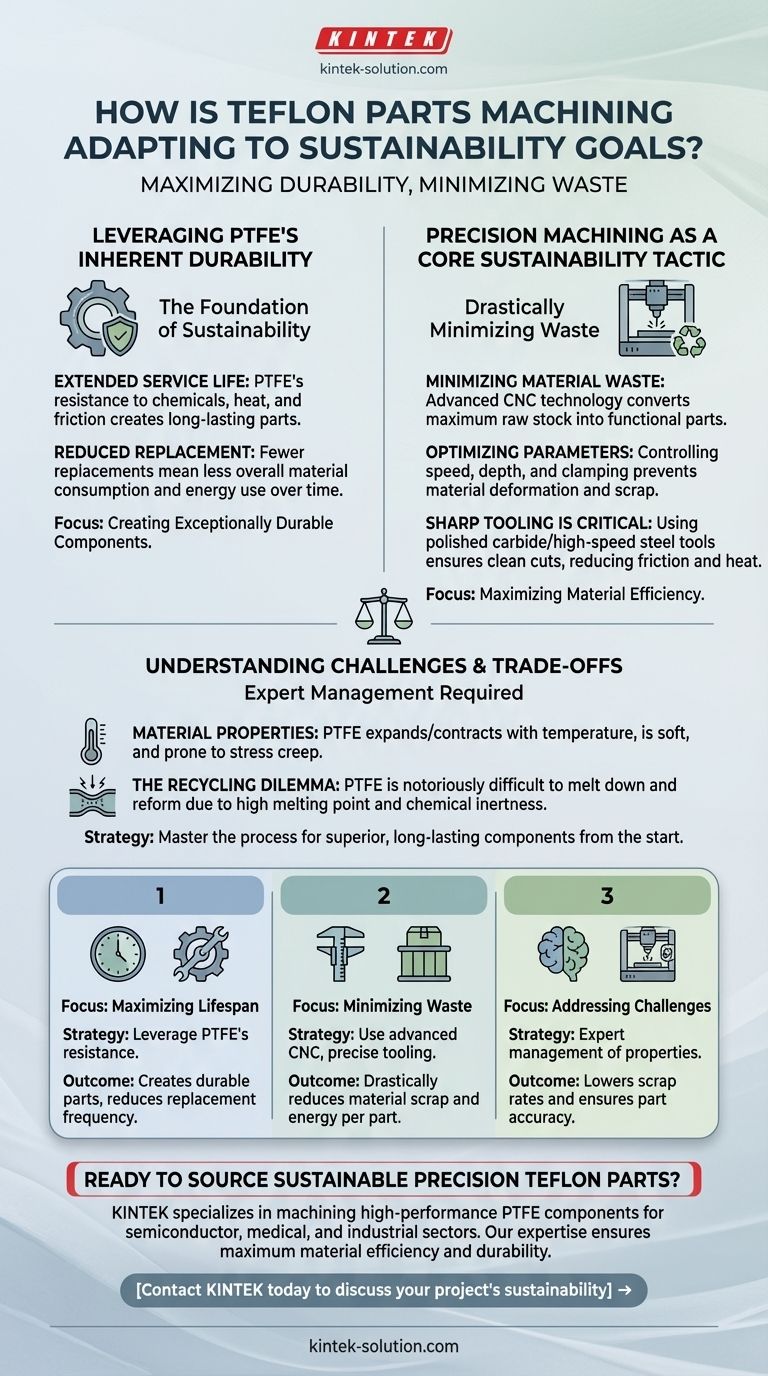In practice, Teflon machining is adapting to sustainability goals by focusing on two primary areas: maximizing the material's inherent durability to create long-lasting parts and employing advanced precision machining techniques to drastically minimize waste during production. While direct recycling of PTFE remains a significant challenge, the core strategy is to make the most of the material from the very beginning.
The most effective sustainability strategy for machined Teflon parts is not centered on recycling, but on maximizing material efficiency. This means leveraging advanced manufacturing processes to create exceptionally durable components with minimal waste, thereby reducing the need for replacements and conserving resources.

The Foundation: Leveraging PTFE's Inherent Durability
The sustainability story of any material begins with its lifespan. A part that does not need to be frequently replaced is inherently more sustainable.
Reducing the Replacement Cycle
Polytetrafluoroethylene (PTFE), the polymer known as Teflon, is exceptionally resistant to chemicals, heat, and friction.
By machining parts that fully leverage this durability, manufacturers extend the service life of equipment. This reduces the overall consumption of materials and the energy required for manufacturing and installation over time.
Precision Machining as a Core Sustainability Tactic
The most significant environmental impact in the machining process is material waste. The modern approach to sustainable Teflon machining is a direct assault on this waste through precision and control.
The Goal: Minimizing Material Waste
Advanced CNC technology and refined machining techniques ensure that the maximum amount of the raw PTFE stock becomes a functional part, not scrap shavings.
This focus on efficiency conserves raw materials and reduces the energy consumed per part produced.
The Importance of Correct Tooling
Tool selection is critical for clean, efficient cuts that prevent waste. Sharp tools are non-negotiable to minimize friction and material deformation.
Machinists often use high-speed steel or carbide tools with highly polished surfaces and positive rake angles. This geometry helps lift the chip away from the part cleanly, reducing heat generation and ensuring a better surface finish without wasting material.
Optimizing Machining Parameters
Controlling variables like cutting speed and depth of cut is essential. The wrong parameters can generate excess heat, causing the material to deform and leading to rejected parts.
Furthermore, the workpiece must be securely clamped to prevent vibration. Any chatter or movement can result in inaccurate cuts and poor surface finishes, turning a valuable piece of stock into waste.
Understanding the Challenges and Trade-offs
Achieving this level of precision with Teflon is not straightforward. The material's unique properties present significant challenges that must be expertly managed.
The Challenge of Material Properties
PTFE is a soft material with a high coefficient of thermal expansion. This means it expands and contracts significantly with temperature changes, making it difficult to hold tight tolerances.
It is also prone to stress creep and deformation under pressure. An inexperienced machinist can easily ruin a part by applying too much cutting or clamping force. These factors make precision difficult and can lead to higher scrap rates if not properly controlled.
The Recycling Dilemma
Recycling post-consumer or scrap PTFE is notoriously difficult. Its high melting point and extreme chemical inertness prevent it from being melted down and reformed like common thermoplastics.
While initiatives to explore recycling exist, the primary sustainability gains in the current landscape come from efficient manufacturing, not end-of-life reprocessing.
Making the Right Choice for Your Goal
To align your project with sustainability goals when using machined Teflon, you must focus your strategy on the most impactful phase of the product lifecycle.
- If your primary focus is maximum component lifespan: Design parts that fully leverage PTFE's chemical and thermal resistance to reduce the frequency of replacement.
- If your primary focus is minimizing manufacturing waste: Partner with a machine shop that has specific expertise in soft plastics and can prove their control over tooling, parameters, and clamping.
- If your primary focus is end-of-life recyclability: Acknowledge that PTFE is not easily recycled and consider whether its extreme durability outweighs this limitation for your specific application.
Ultimately, sustainable Teflon machining is about mastering the process to create superior, long-lasting components right from the start.
Summary Table:
| Sustainability Focus | Key Machining Strategy | Outcome |
|---|---|---|
| Maximizing Lifespan | Leveraging PTFE's inherent chemical & thermal resistance | Creates durable parts that reduce replacement frequency |
| Minimizing Waste | Using advanced CNC, precise tooling, and optimized parameters | Drastically reduces material scrap and energy per part |
| Addressing Challenges | Expert management of PTFE's softness and thermal expansion | Lowers scrap rates and ensures part accuracy |
Ready to source precision Teflon parts that align with your sustainability goals?
KINTEK specializes in machining high-performance PTFE components (seals, liners, labware, and more) for the semiconductor, medical, laboratory, and industrial sectors. Our expertise in advanced fabrication ensures maximum material efficiency and part durability, from prototypes to high-volume orders.
Contact KINTEK today to discuss how our custom PTFE solutions can enhance your project's performance and sustainability.
Visual Guide

Related Products
- Custom PTFE Parts Manufacturer for Teflon Parts and PTFE Tweezers
- Custom PTFE Parts Manufacturer for Teflon Containers and Components
- Custom PTFE Volumetric Flasks for Advanced Scientific and Industrial Use
- Custom PTFE Teflon Balls for Advanced Industrial Applications
- Customizable PTFE Rods for Advanced Industrial Applications
People Also Ask
- What are the unique properties of PTFE? The 3 Pillars Driving Demand for High-Performance Parts
- What challenges arise when machining PTFE (Teflon)? Overcome Softness, Heat, and Instability
- What are the unique properties of PTFE? Unlock Unmatched Performance in Demanding Applications
- What are the main applications of PTFE type Teflon? Unlock Its Versatility for Your Industry
- What fabrication services are available for PTFE? Shearing, Stamping, Laser Cutting, Molding & Machining



















